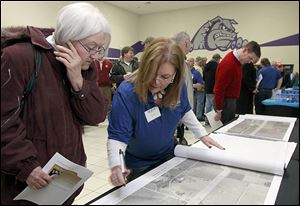
FEATURED EDITORIAL
Safety first
Pipeline projects offer benefits to Ohio and Michigan, but security of people and property must be paramount
2/18/2015
A NEXUS representative shows a property owner a proposed study corridor map at a public forum at Swanton High School last week.
Two proposed natural-gas pipelines in northern Ohio and southeast Michigan offer the promise of bringing the region good jobs, growth and investment, and new tax revenue. Not-in-my-backyard sentiments and excessive fears of explosions or other disasters should not be allowed to scuttle either plan.
But the companies that want to build the underground pipelines and the federal officials who would regulate them still will need to show, not just assert, that the projects are as safe as they reasonably can be made.
Click here to view more Blade editorials
The proposed NEXUS pipeline was the subject of public meetings in the Toledo area this month. The 250-mile transmission line would extend from Columbiana County to Ontario, Canada, including a stretch through metro Toledo.
The other project, the Rover pipeline, would extend more than 800 miles from southeast Ohio to Defiance County, then north to Michigan and Canada. Proponents say it would create 10,000 local construction jobs.
Both projects would transport natural gas extracted from Ohio’s segments of the Utica and Marcellus shale formations, along with gas from other sources. Advocates say the pipelines would provide reliable supplies of gas for manufacturers, power generators, and distributors in Ohio and Michigan.
Arthur Diestel, the manager of stakeholder outreach for NEXUS Gas Transmission LLC, told The Blade’s editorial page that the pipeline’s route will be subject to adjustment throughout this year. The project’s partners, DTE Energy in Michigan and Texas-based Spectra Energy, expect to present the project plan to the Federal Energy Regulatory Commission by year’s end; if the commission approves, construction would start in 2017 and the pipeline would go into service late that year.
It’s not surprising that some property owners and communities along the proposed route have reservations about the plan. They are concerned about the pipeline’s effect on property values, and on traffic congestion and noise pollution during construction. NEXUS Gas Transmission pledges fairness in acquiring right-of-way easements, although those negotiations have not begun.
Farmers in the affected area express concerns about the pipeline’s impact on agricultural land. Mr. Diestel says the company will segregate topsoil from construction areas. “We want to be good stewards, keeping farmers whole during construction and leaving the land better than we found it,” he says.
Overreaction isn’t warranted; federally inspected interstate underground pipelines remain the safest way to transport natural gas, with a 99 percent success rate. Still, the critics cite broader safety issues about the proposed projects that demand to be addressed.
The NEXUS pipeline’s proximity to the environmentally fragile Oak Openings region is a concern for the entire region, not just the project’s neighbors, and must be resolved. Opponents want to limit construction of both projects to an “energy corridor” that they say would promote closer pipeline inspection and monitoring. Mr. Diestel notes that more than 60 percent of the NEXUS route would use existing corridors of overhead power lines and underground utilities.
Assurances alone aren’t enough. A recent study by the National Transportation Safety Board identified lapses in gas pipeline operators’ self-inspection regimens. Regulators need to fix those defects, whether or not the new projects in Ohio and Michigan go forward.
The new projects would help promote the replacement of dirty coal as a power generation source with cleaner-burning natural gas, and also would advance the development of cars and trucks that run on natural gas. Both would be positives for the region’s environment.
But an explosion or major leak would undo, at the very least, all of the advantages of the projects. The pursuit of safety can’t be relative; it must be absolute.